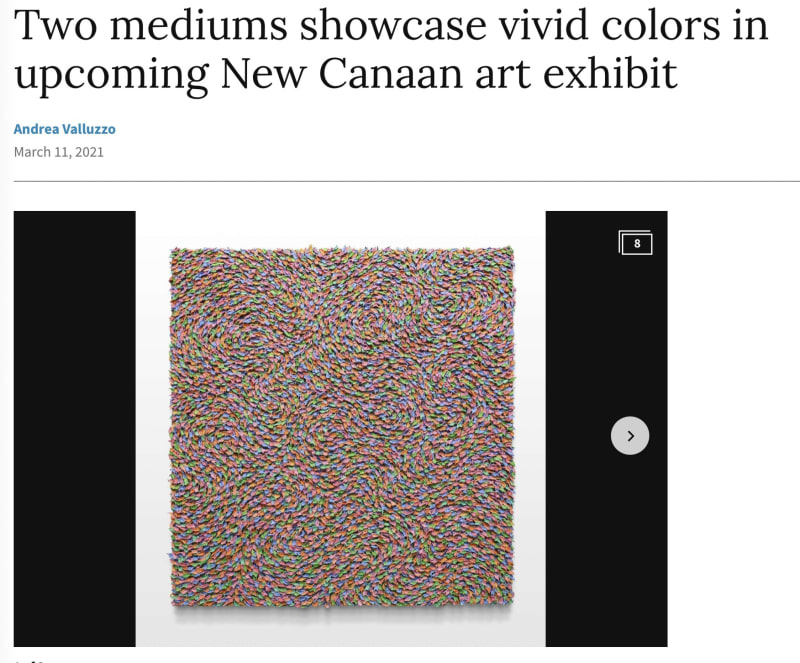From coiled steel pipe sculptures — whose weighty physicality is belied by their airiness — to highly textural paintings practically dripping with layers of vivid hues, color is at the heart of a new exhibition at Heather Gaudio Fine Art in New Canaan.
The show, “Sagerman and Clement: High-Performance Color,” features new paintings by Robert Sagerman and sculptures by John Clement that explore the impact of color. The exhibit runs from March 13-May 1.
In the spirit of Color Field paintings, Sagerman creates abstract paintings that are methodical and lyrical. The artist’s artmaking process is highly methodical; he applies one color and one mark at a time, building up colors and layers into paintings that are quasi-sculptural and can be several inches thick. Their titles, like “5,346” or “26x25,” refer to how many marks and pigments the artist uses in each work.
Boasting degrees in Hebrew and Judaic studies, Sagerman has been deeply influenced by 13th century Jewish mysticism; the counting practice he employs in his art-making is a Kabbalist tradition. Counting is a meditative act that is used as a way to achieve states of clarity and transcendence.
Using this approach, Sagerman sometimes finds himself surprised by the color directions — and the finished painting — that results.
“For me, painting is a contemplative practice where obviously I’m very absorbed in the materiality of what I am doing,” Sagerman said. “There is kind of a devotional aspect with the application of the material, kind of meditative repetitive act. I can almost feel like a bystander. There was no single decision that was all that momentous because the painting would kind of emerge on its own. I could just kind of have the feeling that I was watching what was happening and in that way I could make a painting stronger than if I was trying to impose something on it.”
Interestingly, as much of the world was locked down last year, Sagerman’s work began to be more freeing. After doing mostly monochromatic works with a limited color palette, his recent work is more exuberant. “This body of work is kind of a phase where things opened up,” he said. “It’s nice that after two or three shows where everything was pretty strictly monochrome and kind of constrained, [the work in] this show is very open.”
Clement’s coiled-steel pipe sculptures typically weigh between 500 and 4,000 pounds. In his signature coils and arc forms, these pieces have a deftness to them, with lots of negative space in between the heavy pipes. The circular nature also adds to the illusion that they can spin or be in motion. There is a lot of volume and scale to these pieces, but having negative space keeps them light and airy.
Clement is always creating new work; for this exhibit, he began gathering pieces and setting aside ones that would work together. The goal became “seeing how they played off each other, how they would compare and sort of have conversations in the space with one another,” he said.
Sparking these conversations is personality. Each piece has a different scale, size, form and way to occupy space, Clement said. “They are such three-dimensional objects and 360 degrees around, every view is different … how they reach out, stretch out and come back around, maybe lean over a little too far or are really self contained and tight.”
The exhibition’s title, “High Performance Color,” speaks to the intensity of the vibrant colors in the paintings and sculptures but also alludes to Clement’s artmaking process of using high-performance automotive paint to finish his sculptures. More interestingly, it points out a dichotomy between how sculpture is made compared with a painting.
“It is an interesting title, because when you are making sculpture, the last thing that you’re thinking about is the finished surface, which is the total opposite of how one goes about a painting,” Clement said. “As you are making a painting and building up the layers, it’s all about color and how the colors go together and your palette ... but with sculpture, color is usually the last thing you think about. In fact, I never choose a color until that piece is done.”
For more information, visit heathergaudiofineart.com.
Andrea Valluzzo is a freelance writer.

